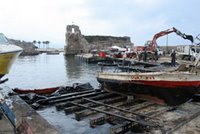"My compassion goes first to the men, women and, especially, the children, who are experiencing the ordeal of fire, shelling and despair. Nevertheless, we must also think about our immense responsibility towards sites such as Tyre, Baalbek, Byblos, Anjar, the Holy Valley and the Forest of the Cedars of God, in Lebanon, and the Old City of Acre in Israel. All these names - names that stir the imagination - are symbols of the encounter of religions and cultures that are universally recognized as our common heritage.Of course, Lebanon and Israel hold a vastly disproportionate share of the World's Heritage. Fortunately, it appears that little lasting damage was done to the most important World Heritage sites. Still, given the demands on the resources of these nations to repair the damage done during the fighting, it will be important that the long term effort to protect the heritage from millennia past not be forgotten. USA Today this week reported that "Three UNESCO World Heritage sites in Lebanon need urgent repairs"
"This is why - in keeping with The Hague Convention for the Protection of Cultural Property in the Event of Armed Conflict (1954), and by virtue of the Convention concerning the Protection of the World Cultural and Natural Heritage (1972), conventions of which both Israel and Lebanon are signatories - I solemnly request that all necessary measures be taken to safeguard and protect these cultural properties of inestimable value.
 Oil Slick in the Old Port of Byblos ©UNESCO/Studionada
Oil Slick in the Old Port of Byblos ©UNESCO/StudionadaUNESCO recently sent a team of experts to Lebanon to assess the state of the places in that country that have been enrolled as UNESCO World Heritage Sites. At press conference on their return, they called for urgent measures to clean up the oil spill from the World Heritage edifices along the Byblos shore line. Despite the limited extent of war damage to cultural heritage, the mission found several areas that require attention to safeguard and revitalize that heritage. The mission noted that the souk and some old houses in the Old City of Baalbek, not part of the property inscribed on the World Heritage List, were damaged by bombs.
 The Roman City of Baalbek ©UNESCO
The Roman City of Baalbek ©UNESCOMr Bouchenaki,Director-General of the International Centre for the Study of the Preservation and Restoration of Cultural Property (ICCROM), outlined more longer-term measures to preserve Lebanon’s cultural heritage: Setting up photogrammetric equipment to monitor fissures in several sites; helping Lebanon’s Department of Antiquities develop its human resources to improve the safeguarding and management of cultural heritage sites; drawing up of a risk map identifying cultural properties with serious structural weaknesses; and undertaking measures to consolidate the most seriously threatened structures.
UNESCO’s Assistant Director-General for Culture stressed the importance of culture as a cement of social cohesion in Lebanon and spoke of the importance of cultural heritage as a symbol of the country’s diversity and tolerance.
UNESCO is preparing to send another, multidisciplinary mission to Lebanon to assess ways in which the Organization may contribute to reconstruction in culture, education, science and communication, in the framework of the United Nations’ plan for Lebanon.
Video of the Press Conference
Editors Note: The ruins of many successive civilizations are found at Byblos, one of the oldest Phoenician cities. Inhabited since Neolithic times, it has been closely linked to the legends and history of the Mediterranean region for thousands of years. Byblos is also directly associated with the history and diffusion of the Phoenician alphabet. Visit UNESCO's Bylbos World Heritage Site website.
Baalbek was a city in the time of the Phoenicians. It was known as Heliopolis during the Hellenistic period. During Roman times the city's sanctuary of the Heliopolitan Jupiter attracted thousands of pilgrims. Baalbek, with its colossal structures, is one of the finest examples of Imperial Roman architecture at its apogee. Visit UNESCO's Baalbek World Heritage Site website.
No comments:
Post a Comment